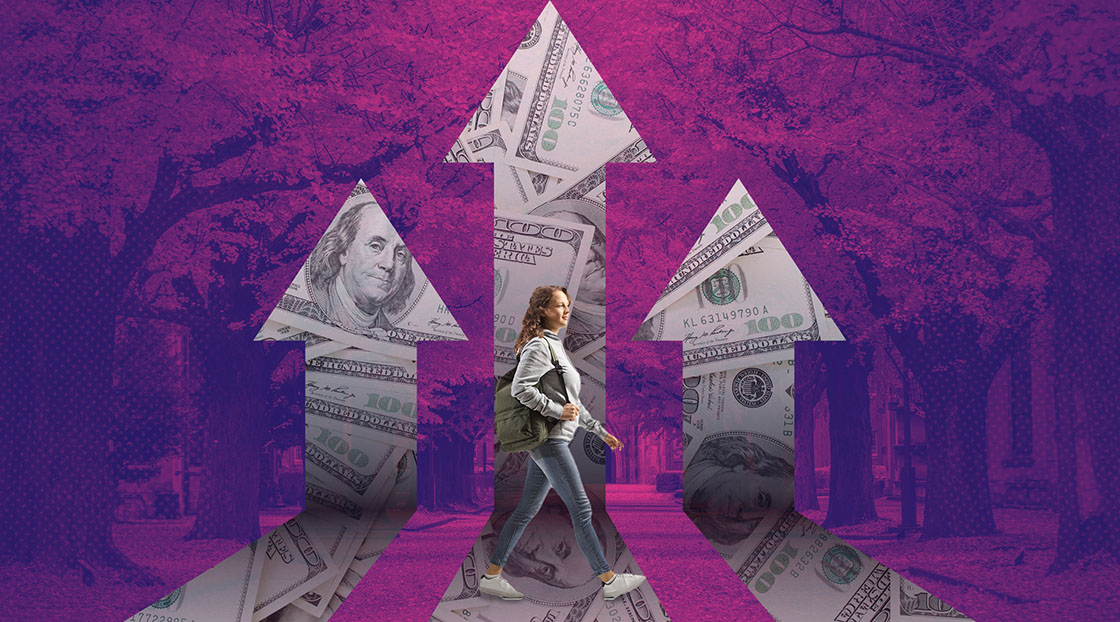Between a global pandemic and nationwide labor shortages, prices have risen higher than they have been in 40 years. As prices soar and the public eye stays trained on the benefit of higher ed in relation to its value, many universities must now decide whether their students will shoulder the rising cost of education or take other measures to divert expenses.
Mark Bullion, media and public information communications manager for Michigan State University, said, “Leadership remains very sensitive to the financial stresses students and families have experienced throughout the COVID-19 pandemic and our current economy’s inflation.”
According to the Bureau of Labor Statistics, as of June 2022, the inflation rate was 9.1%, higher than it has been in decades, with an accompanying average tuition inflation rate of 8% as of August 2022. This increase is significant compared to the 3.11% inflation rate that four-year public institutions saw between 2010 and 2020. Notably, community colleges saw a more drastic increase of 43.4% during the same period.

Tuition Increases
In light of the ongoing inflation, many universities are considering tuition adjustments and increases to help offset the rising cost of expenses. The inflation burden is impacting not only the costs of operations but also the need for cost-of-living increases for faculty and staff.
Tuition prices at MSU have not changed in the past four years, until now. MSU implemented a 2% increase, which is considerably less than inflationary rates, for incoming first-years for the 2022-23 academic year.
“The minor increase was necessary to maintain and grow investments in student support programs but will ultimately result in increased persistence and graduation rates,” explains Bullion. For the past four years, the MSU sticker price hovered at approximately $29,230 for a full-time in-state student. The inflated price brings the final cost for a full-time first year to $29,814.60 – an approximately $600 per year increase.
In other areas of the country, institutions are considering measures to increase tuition costs for new students, while maintaining lower rates for returning students. Due to the University of Arizona’s guarantee program, the institution reported that existing students will not encounter massive price increases. The guarantee program ensures that students pay a fixed amount each year they attend, which is based on the set tuition for the year they were admitted, rather than paying the new rate each year.
“As with recent years, more than 99% of continuing undergraduate students will experience no increase in tuition or mandatory fees for 2022-2023 due to their enrollment in the tuition guarantee program,” stated President Robert C. Robbins of the University of Arizona, in a proposal to the Arizona Board of Regents.
Although the increase will not affect existing students, it will affect incoming students. Resident graduate and undergraduate tuition will increase by 2%, and nonresident undergraduate tuition will increase by 5.6%, with no raise in nonresident graduate tuition.
Tuition Freezes
Raising tuition prices is one strategy to offset the effects of inflation, but not the only one. St. Mary’s College of Maryland has decided to freeze tuition in their “Long-Range Tuition Strategy,” which they plan to use for the next 10 years.
“The model factors in additional assumptions based on enrollment, a continued state funding formula, additional revenues from events and conferences, and accounts for the annual increase in various expense categories,” explained Paul A. Pusecker III, vice president for business and chief financial officer. Pusecker noted that the college also considered costs such as utilities, fuel, service fees, dining services and other expenses for the 2023 fiscal budget prior to deciding on the institution-wide tuition freeze.
Historically, tuition freezing has negatively impacted students who seek financial aid rather than those paying directly out of pocket. According to a 2021 Hechinger Report study, the negative side effects of tuition freezing are felt by students paying the sticker price, which can be detrimental for low-income families. As tuition prices can be drastically different for each student, students relying on financial aid may see less of a benefit from a tuition freeze compared to an across-the-board tuition increase.
The greatest concern is making sure the students can continue to pay for their education as they navigate increased prices at the gas pump, in the grocery store and in every other aspect of their lives.
According to David Hautanen Jr., vice president of enrollment management at St. Mary’s, the institution was conscious of this possible disparity but believes the tuition freeze will benefit the majority of students.
“Our tuition freeze, along with our investment in financial assistance, is a sign of our commitment to ensuring that all families have access to an exceptional and affordable education,” said Hautanen.
Debates in higher education circles continue on how best to level the tuition playing field for all students when implementing tuition freezes. For now, the greatest concern is making sure the students can continue to pay for their education while simultaneously navigating increased prices at the gas pump, in the grocery store and in every other aspect of their lives. Leaders at St. Mary’s College believe that the proposed 10-year plan is the most efficient way to achieve this goal and to ensure continued student financial and academic success.
“The 10-year plan strengthens our long-standing value proposition of a liberal arts honors education at a public college price, one that has been recognized extensively in outside rankings and empirical data such as our low average debt and low student loan default rates,” said Chuck Steenburgh, assistant vice president for integrated marketing and communications.
Future Outlook
Although the rising costs of universities has been an ongoing matter of concern, many institutions are striving to find the perfect balance between the students’ needs and keeping the institutions’ proverbial lights on. These are uncertain economic times for all, even for institutions with rock-solid plans.
Only one thing is clear; inflation is an inevitable part of the financial landscape that universities and students will have to navigate in the coming years. It is still too soon to know exactly what to expect from institutions in the 2023-24 school year, but it seems most colleges have begun to factor inflation into their budgets.







